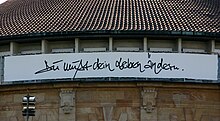Archaic Torso of Apollo

"Archaic Torso of Apollo" (German: Archaïscher Torso Apollos) is a sonnet by the Austrian writer Rainer Maria Rilke, published in the collection New Poems in 1908. It opens the collection's second part and is a companion piece to "Early Apollo", which opens the first part. The poem describes the impressions given by the surviving torso of an ancient statue, which for the poet creates a vision of what the intact statue must have been like.
Summary[edit]
"Archaic Torso of Apollo" is a sonnet with the rhyme scheme AbbA CddC EEf GfG.[1] It is an ekphrasis—a rhetorical genre from ancient Greece that describes inanimate objects—of an ancient statue of Apollo, of which only the torso and crotch area survive. The poem argues that although the head is missing, the characteristics of the remaining body give an impression of what the complete statue must have been like. The impression creates a sense of being observed and a need to change one's own life.
Publication[edit]
Rainer Maria Rilke's poetry collection New Poems was published in two parts in 1907 and 1908. The first part opens with "Early Apollo" (German: Früher Apollo) and the second with "Archaic Torso of Apollo". Other English titles include "Torso of an Archaic Apollo" and "Apollo's Archaic Torso".[2]
Analysis and reception[edit]
Rilke had discussed the relationship between the fragment and the whole in prose texts, notably in reference to the sculptures of Auguste Rodin, writing that "Rodin knows that the body consists of so many stages for the display of life...and he has the power to bestow on any part..the independence and completeness of a whole".[3] Part two of New Poems contains a dedication to Rodin, right before "Archaic Torso of Apollo", and the poem has been interpreted as a tribute to Rodin.[4]
"Early Apollo" and "Archaic Torso of Apollo" function as companion pieces through their roles as opening poems, descriptions of Apollo statues and thematic similarities. The scholar Charlie Louth writes that their respective adjectives are complementary, where "early" becomes a promise about the poetry that will follow, and "archaic" refers to a restoration of something original and complete, which Louth writes that the poem achieves despite the fragmentary state of the statue that inspired it.[5] According to Louth, "Early Apollo" creates anticipation and "Archaic Torso of Apollo" demands that the reader contributes to a new beginning that can match the poem's achievement of fullness, as expressed in its final sentence: "you must change your life".[6]

The philosopher Peter Sloterdijk used the final line of "Archaic Torso of Apollo" in the title of his book You Must Change Your Life, published in 2009. According to Sloterdijk, the line expresses the "absolute imperative—the quintessential metanoetic command".[7]
It is not known for certain what statue Rilke thought of when he wrote "Archaic Torso of Apollo". The archaeologist Ulrich Hausmann argued in 1947 that the poem's subject was the Miletus torso (c. 480–470 BC), a sculpture of a young man at the Louvre. The literary scholar Paul Böckmann argued that this is improbable and suggested other possibilities.[8]
References[edit]
Citations[edit]
- ^ Gräff 1991, p. 90.
- ^ University of Pennsylvania/Charles Bernstein.
- ^ Fischer 2015, p. 180.
- ^ Fischer 2015, pp. 180–181.
- ^ Louth 2020, p. 8.
- ^ Louth 2020, pp. 8–9.
- ^ Mendieta 2014.
- ^ Fischer 2015, p. 289.
Sources[edit]
- Fischer, Luke (2015). The Poet as Phenomenologist: Rilke and the New Poems. New Directions in German Studies. Vol. 10. New York and London: Bloomsbury Academic. ISBN 978-1-6289-2543-2.
- Gräff, Thomas (1991). Gedichte der Jahrhundertwende (1890—1910). Interpretationen. Munich: R. Oldenbourg Verlag. ISBN 3-486-88648-7.
- Louth, Charles (2020). Rilke: The Life of the Work. Oxford: Oxford University Press. ISBN 978-0-19-881323-1.
- Mendieta, Eduardo (18 July 2014). "You Must Change Your Life". Notre Dame Philosophical Reviews. Retrieved 13 May 2024.
- "Rainer Maria Rilke". University of Pennsylvania/Charles Bernstein. Retrieved 13 May 2024.
Further reading[edit]
- Groddeck, Wolfram (1999). "Blendung. Betrachtung an Rilkes zweitem Apollo-Sonett". Interpretationen: Gedichte von Rainer Maria Rilke (in German). Stuttgart: Reclam. pp. 87–103. ISBN 3-15-017510-0.
- Hausmann, Ulrich (1947). Die Apollosonette Rilkes und ihre plastischen Urbilder. Kunstwerk und Deutung (in German). Vol. 2. Berlin: Gebr. Mann Verlag.
External links[edit]
 German Wikisource has original text related to this article: Archaïscher Torso Apollos
German Wikisource has original text related to this article: Archaïscher Torso Apollos Works related to "Archaic Torso of Apollo", translated by Jessie Lemont, at Wikisource
Works related to "Archaic Torso of Apollo", translated by Jessie Lemont, at Wikisource- The Archaic Torso of Apollo, translated by William Ruleman, The Ekphrastic Review
- Apollo's Archaic Torso, translation by Sarah Stutt, The Guardian's book blog
